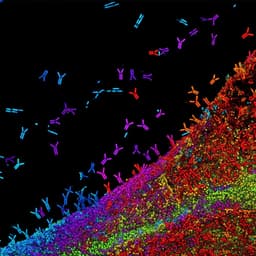
Medicine and Health
Prenatal environment is associated with the pace of cortical network development over the first three years of life
U. A. Tooley, A. Latham, et al.
This innovative study conducted by Ursula A. Tooley and colleagues at Washington University in St. Louis explores the link between prenatal disadvantage and brain development in early childhood. The findings reveal accelerated cortical network segmentation associated with socioeconomic factors, particularly influencing sensorimotor regions and language abilities. Discover how early adversity can shape cognitive growth from birth to three years.
~3 min • Beginner • English
Introduction
The study investigates whether features of the early environment—specifically prenatal socioeconomic disadvantage—are associated with the pace of cortical functional network development from birth to three years. Early life is marked by rapid refinement of intrinsic cortical organization and increasing segregation of large-scale networks; however, the extent to which the early environment alters the tempo of these trajectories is unclear. Prior work suggests that children from more advantaged backgrounds may show more protracted development, while disadvantage may be linked to accelerated maturation and earlier declines in plasticity. Drawing on evolutionary-developmental and life-history models, the authors hypothesized that prenatal disadvantage would be associated with faster age-related increases in cortical network segregation during infancy and toddlerhood. Using a longitudinal cohort with repeated neuroimaging and detailed socioeconomic characterization, they tested whether infants and toddlers from more disadvantaged prenatal environments demonstrate accelerated increases in functional network segregation, and whether such neural differences relate to early language and cognition.
Literature Review
Previous research in older children and adolescents shows that socioeconomic status (SES) moderates trajectories of cortical network segregation, with youth from higher-SES backgrounds exhibiting lower segregation earlier but steeper increases through adolescence, ultimately reaching higher segregation in adulthood. Disadvantage is multifaceted (income, education, occupation, insurance, diet) and is linked to broad outcomes including physical health, cognition, and mental health. Theoretical accounts propose that early adversity can alter maturational tempo: harsh or unpredictable conditions may accelerate development, while safe and enriched environments may prolong plasticity. The “change of tempo” model suggests different adversity forms have distinct effects on pace (e.g., deprivation vs threat). Environmental associations with intrinsic brain organization are detectable as early as the first months of life, but longitudinal studies across the first years have been lacking. Prior work in infancy has linked SES to intrinsic connectivity patterns by 6 months and observed that maturation proceeds along a sensorimotor-to-association cortical hierarchy. Together, this literature motivates testing whether prenatal disadvantage accelerates functional network segregation during the first three years and how such neural changes relate to emerging behavior.
Methodology
Design and participants: Longitudinal cohort from the eLABE study (parent March of Dimes cohort). Mothers enrolled in 2nd–3rd trimesters with oversampling for adversity. Inclusion: English-speaking, age ≥18, singleton; exclusions included preterm birth (<37 weeks GA), brain injury, significant neonatal complications, certain pregnancy complications, and fetal abnormalities. Final imaging samples: neonates n=261 (38–45 PMW), year 2 n=92 (1.91–2.61 years), year 3 n=66 (2.92–3.97 years). Ethics approved; informed consent obtained; participants compensated.
Imaging acquisition: 3T Siemens Prisma with 64-channel head coil; structural T2 (neonates) or T1 (2- and 3-year) at 0.8 mm isotropic. Resting-state fMRI: multiband EPI (2.0 mm iso, TR=800 ms, TE=37 ms, MB=8, 420 vols), 7.5–44.8 min per session; spin-echo field maps collected. FIRMM used for motion monitoring.
Preprocessing: Standard steps including intensity corrections, normalization, motion realignment, registration to Talairach atlas via age-appropriate intermediate templates (neonates via group T2, toddlers via group T1). TOPUP for distortion correction. Surface mapping via MCRIB (neonates) or FreeSurfer 7.2 (toddlers); Connectome Workbench used. Denoising with nuisance regression (WM, ventricles, CSF, whole brain; 24-parameter motion expansion), band-pass 0.005–0.1 Hz; demean/detrend; interpolate censored frames. Motion censoring: neonates FD>0.25 mm; toddlers FIRMM-filtered FD>0.2 mm; require ≥3-frame low-motion epochs. Inclusion required ≥5 min usable data (99% had >10 min). Covariates included number of retained frames and average FD.
Network construction: 333-region cortical parcellation; weighted, signed FC matrices from Fisher z-transformed Pearson correlations. Nodes assigned to 13 large-scale systems (adult-defined, given limited consensus on neonatal systems).
Network metrics: Segregation quantified at three scales: global (system segregation), meso-scale (modularity Q), and local (clustering coefficient). Integration measured by participation coefficient. Whole-brain averages and region-wise local segregation assessed.
Socioeconomic exposure: Prenatal disadvantage quantified as a latent factor (CFA in MPlus) incorporating mother’s income-to-needs ratio, educational attainment, area deprivation index (ADI), insurance status, and nutrition (Healthy Eating Index). Higher factor scores indicate more disadvantage. Sensitivity analyses also used a composite SES (education + income-to-needs).
Behavioral outcomes: Bayley-III cognitive and language composites at ages 2 and 3; receptive and expressive language subscales analyzed.
Statistical analysis: Pre-registered generalized additive mixed models (GAMMs, mgcv in R) modeled segregation/integration versus age with smooth terms, participant random intercepts, and covariates (sex, motion, retained frames, average network weight). Age-by-disadvantage interactions tested (varying-coefficient model favored by BIC). Significance via parametric bootstrap LRT; FDR correction applied. First derivatives of age smooths quantified rate-of-change windows. Cross-scale models controlled for other segregation metrics to identify fundamental drivers. Region-wise GAMMs evaluated spatial patterning (FDR across parcels); system-level enrichment tested via Kruskal–Wallis. Spatial correspondence with the sensorimotor–association (S-A) axis tested via Spearman correlation with spin tests (10,000 rotations). Linear models related 2- and 3-year local segregation to Bayley scores with covariates and FDR correction. Sensitivity analyses assessed robustness to alternative SES measure, head motion, sample composition, temporal SES changes, longitudinal modeling choices, and outliers.
Key Findings
- Developmental increases in segregation: Across scales, cortical network segregation increased with age from birth to 3 years: global (Fs(age)=6.26, EDF=2.26, p=0.001, PFDR=0.001), meso-scale (Fs(age)=3.93, EDF=1.90, p=0.014, PFDR=0.014), and local (Fs(age)=43.23, EDF=2.33, p<0.001, PFDR<0.001). Derivative analyses indicated the strongest increases occurred mainly in the first two years (global: 0–1.93 y; meso: 0–1.70 y; local: 0–2.13 y).
- Prenatal disadvantage moderates tempo: Higher prenatal disadvantage was associated with faster increases in segregation, yielding higher segregation by toddlerhood: global (F(age×SES)=6.38, p=0.002, PFDR=0.002), meso (F=9.86, p<0.001, PFDR=0.001), and local (F=13.40, p<0.001, PFDR<0.001).
- Local scale drives effect: When controlling for local segregation, age×disadvantage effects on global and meso became nonsignificant (global F=2.62, p=0.074; meso F=0.76, p=0.471). Conversely, controlling for global or meso did not diminish the local effect (global-in-model: F=9.46, p<0.001; meso-in-model: F=4.60, p=0.011), indicating local topology underlies the observed effects.
- Regional patterning and system enrichment: 56% of cortical parcels showed significant age×disadvantage effects on local segregation (PFDR<0.05). Effects were enriched in sensorimotor and related systems (somatomotor-hand, somatomotor-mouth, dorsal attention, visual, frontoparietal). The magnitude of parcel-wise effects negatively correlated with the sensorimotor–association axis rank (Spearman ρ=-0.33, pspin=0.002, 95% CI [-0.43, -0.24]), indicating stronger environmental associations at the sensorimotor pole.
- Behavioral associations: Disadvantage-related divergence in Bayley language and cognitive composite scores was evident from age 2 (language: Fs(age×SES)=7.54, p<0.001, PFDR<0.001; cognitive: Fs(age×SES)=12.65, p<0.001, PFDR<0.001). Average whole-cortex local segregation at 2 years was negatively associated with concurrent language composite (t(83)=-2.45, p=0.017, PFDR=0.033, β=-0.23), but not cognitive scores (t(83)=-0.30, p=0.766). Controlling for prenatal disadvantage, both disadvantage (t(83)=-2.26, p=0.027, β=-0.23) and local segregation (t(83)=-2.43, p=0.017, β=-0.25) independently predicted language. Local segregation related negatively to both expressive (t(83)=-2.19, p=0.032, β=-0.21) and receptive (t(83)=-2.18, p=0.032, β=-0.21) subscales; when additionally controlling for disadvantage, receptive remained significant (t(83)=-2.33, p=0.022, β=-0.25). At age 3, similar negative associations with language were observed (composite: t(83)=-2.84, p=0.006, PFDR=0.012, β=-0.33), though significance attenuated when controlling for disadvantage.
- Network integration: Participation coefficient increased with age (Fs(age)=14.11, EDF=1.68, p<0.001, PFDR<0.001; significant change to ~2.27 y), but prenatal disadvantage did not significantly moderate integration trajectories (Fs(age×SES)=1.71, p=0.182, PFDR=0.182).
- Robustness: Findings replicated using an alternative SES composite (income-to-needs + maternal education) and were robust to checks on head motion, sample composition over time, SES changes over the study, longitudinal modeling choices, and outliers. No significant associations were found for prenatal psychosocial stress independent of socioeconomic disadvantage.
Discussion
The results support the hypothesis that prenatal socioeconomic disadvantage is associated with an accelerated pace of cortical functional network development in the first three years of life. Infants and toddlers from more disadvantaged backgrounds exhibit faster age-related increases in network segregation, particularly at the local scale, culminating in higher segregation in toddlerhood. Spatially, environmental associations follow the sensorimotor–association hierarchy, with strongest effects in early-developing somatosensory systems (somatomotor, dorsal attention, visual) and notable involvement of frontoparietal regions. These patterns align with models positing that early environments influence maturational tempo, potentially via earlier reductions in plasticity or altered inhibitory/synaptic developmental processes. The negative association between local segregation at age 2 and language performance suggests that, at this early developmental stage, lower segregation (more widespread connectivity) may be advantageous for language, consistent with a protracted developmental trajectory in more advantaged contexts and with prior observations that the direction of segregation–behavior associations is age- and domain-dependent. The lack of environmental moderation of network integration indicates that disadvantage selectively influences segregation-related aspects of network maturation during this window. Together, findings imply that early socioeconomic conditions shape how rapidly local network architecture differentiates, with potential implications for sensitive periods, later cognition, and intervention timing.
Conclusion
This study demonstrates that prenatal socioeconomic context is linked to the tempo of intrinsic cortical network maturation from birth to age three. Greater prenatal disadvantage predicts accelerated increases in network segregation—driven by local topology and most pronounced in sensorimotor systems—and these neural differences relate to early language outcomes. The work advances understanding of how early environments sculpt neurodevelopmental trajectories and underscores the importance of policies and interventions supporting families during pregnancy and early childhood. Future research should delineate mechanisms (e.g., deprivation, stress biology, enrichment, variability of experience), extend analyses with infant-specific parcellations, integrate prenatal neural measures, and follow cohorts into later childhood to assess long-term cognitive and mental health consequences and critical windows for intervention.
Limitations
- Disadvantage is multidimensional; this study focused on socioeconomic components and did not explicitly model other forms such as discrimination and systemic racism, which may independently affect brain development.
- Toddler sample sizes at ages 2 and 3 were reduced due to COVID-19 impacts, making behavioral analyses at these timepoints more exploratory.
- Adult-derived cortical parcellation and system definitions were used; infant-specific parcellations may better capture developmental topology and could affect segregation estimates.
- Analyses focused on postnatal intrinsic cortical networks; prenatal brain development mechanisms were not directly measured.
- While associations between local segregation and language were observed, causal inferences cannot be made; some effects at age 3 attenuated when controlling for disadvantage.
- Participants returning at year three were somewhat more advantaged, potentially introducing attrition bias.
Related Publications
Explore these studies to deepen your understanding of the subject.







